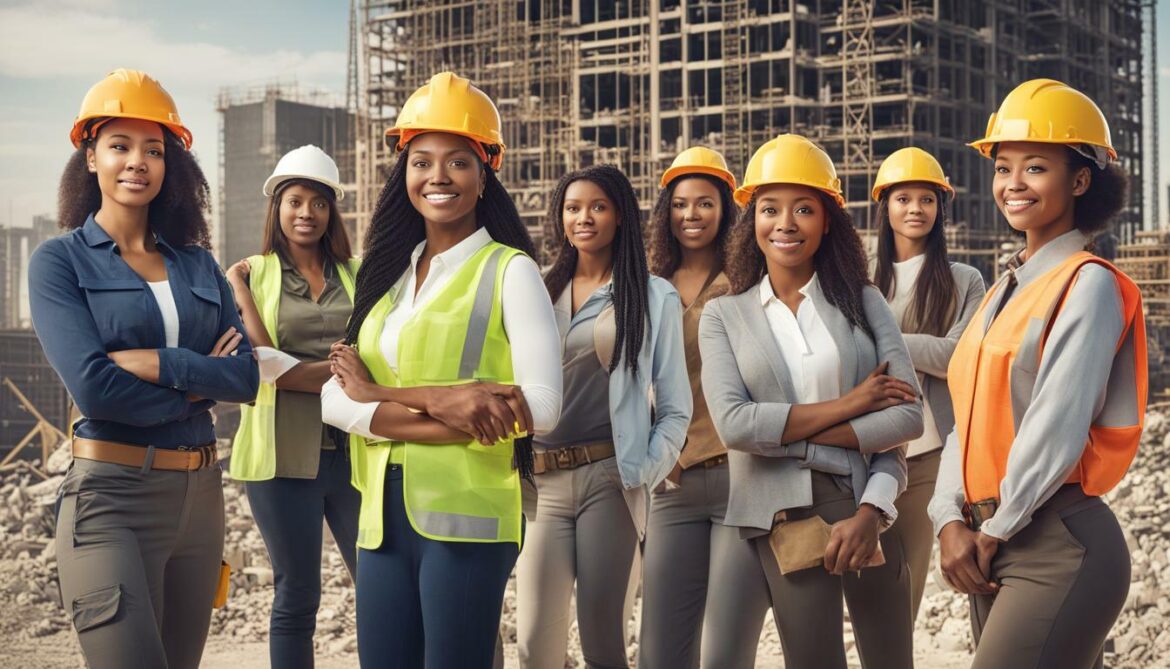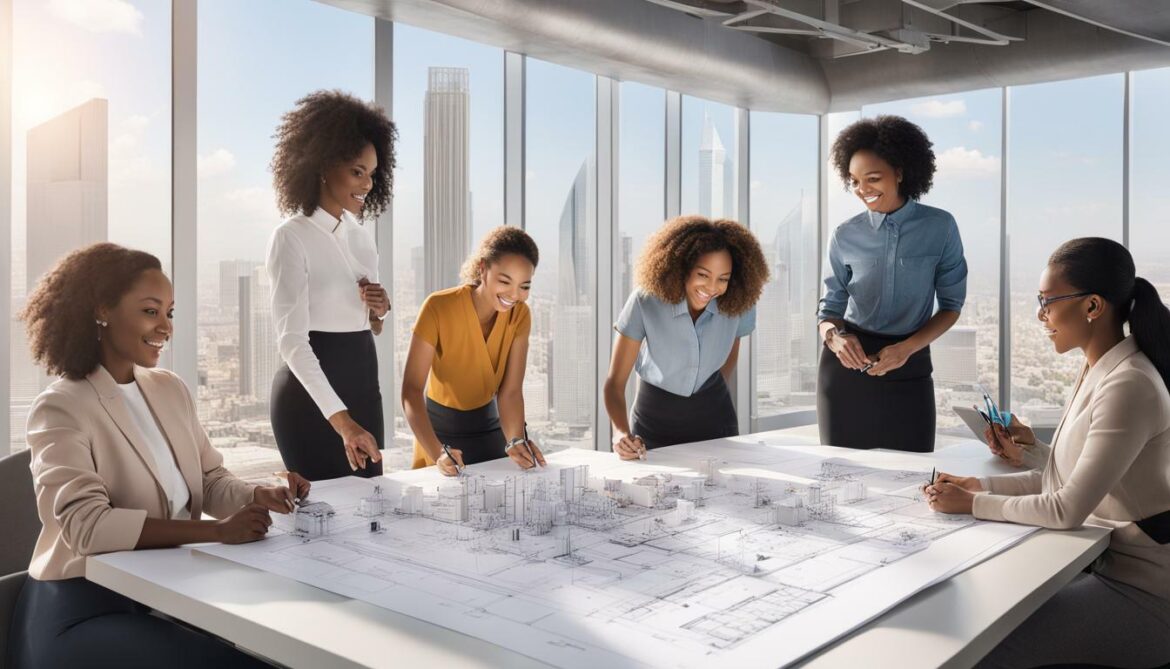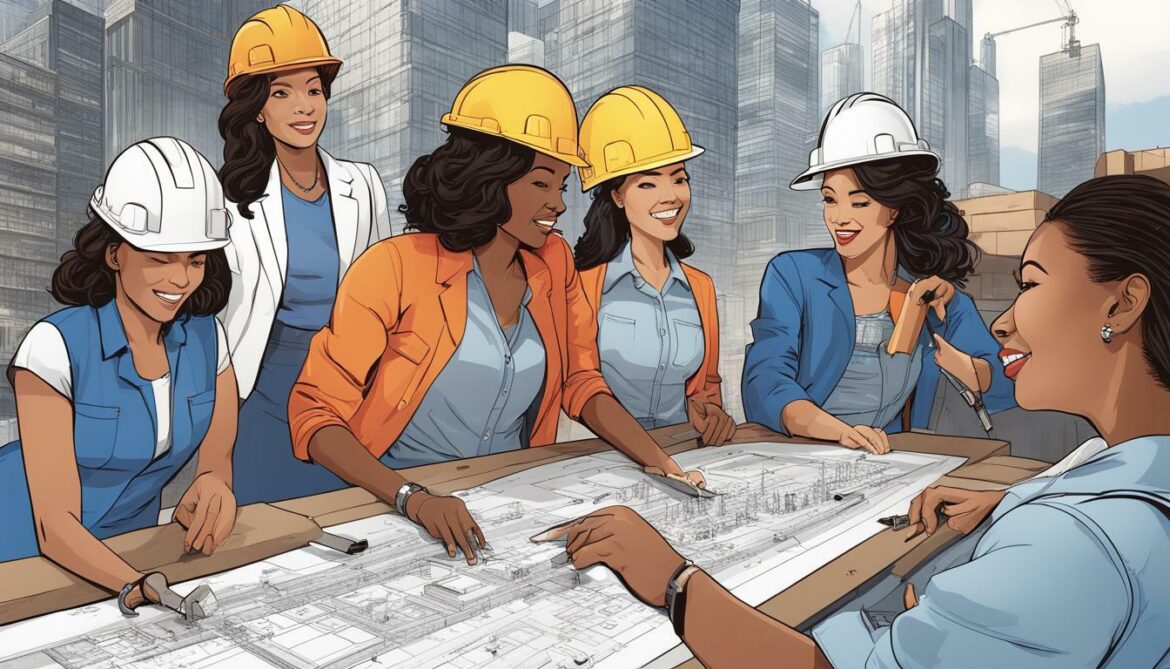Breaking Barriers: Women Shaping the Built Environment Through Engineering
Engineering has long been considered a male-dominated field, but in recent years, women have been breaking barriers and making significant strides in shaping the built environment. From designing sustainable infrastructure to leading large-scale construction projects, women engineers, architects, and construction professionals are making their mark in the industry.
Women in engineering, construction, and architecture bring unique perspectives, skills, and experiences that are essential to the field. Their contributions are helping to shape the future of the built environment and creating more diverse and inclusive workplaces.
Key Takeaways:
- Women are making significant contributions in shaping the built environment through engineering, construction, and architecture.
- Their unique perspectives, skills, and experiences are essential to creating more diverse and inclusive workplaces.
- Gender diversity in the industry is essential to driving innovation, progress, and change.
The Rise of Women in Engineering
Engineering has long been considered a male-dominated field, but in recent years, there has been a significant rise in the number of women pursuing careers in engineering. This increase in diversity in the built environment is not only breaking down barriers for women, but it is also empowering them to make valuable contributions to the industry.
Initiatives aimed at promoting diversity and women empowerment in engineering have played a crucial role in this rising trend. These initiatives have helped to create a more supportive environment for women in engineering, providing them with the mentorship, training and resources they need to succeed.
Women engineers bring unique perspectives to the table, and they are driving innovation and change in the industry. From designing sustainable infrastructure to developing new technologies, women in engineering are making a significant impact on the built environment.
The Importance of Diversity in the Built Environment
The rise of women in engineering is a positive step towards achieving greater diversity and equality in the built environment. Diversity is essential for innovation and creativity, and it helps to ensure that different perspectives are considered in the design and development of infrastructure and buildings.
For too long, the built environment has been shaped by a narrow range of perspectives, resulting in structures that do not always meet the needs of everyone who uses them. Women engineers bring different experiences and insights, as well as a fresh perspective, to the industry. This can lead to better, more inclusive design and construction, resulting in infrastructure that is accessible to all.
Empowering Women in Engineering
Empowering women in engineering is essential for achieving greater gender equality in the field. This empowerment can take many forms, including providing mentorship, training and leadership opportunities to women in engineering.
Organizations like Women in Engineering (WIE) and the Society of Women Engineers (SWE) are working to empower women in the industry by providing networking opportunities, mentorship programs, and scholarships to women pursuing careers in engineering. These initiatives help to foster a sense of community and support for women in engineering, providing them with the tools they need to succeed.
Additionally, industry leaders and decision-makers are recognizing the importance of gender diversity in the industry. By addressing unconscious bias and promoting inclusivity, these leaders are creating a more welcoming environment for women in engineering, and paving the way for greater representation and opportunities in the future.

As more women enter the field of engineering and contribute their unique perspectives and skills, the built environment will continue to evolve and improve. Greater diversity in the industry means better outcomes for everyone, and women in engineering are playing a vital part in achieving this goal.
Women Breaking Barriers in Construction
The construction industry has historically been male-dominated, but women are making significant strides in breaking down barriers and achieving gender equality. With the rise of women in construction, the industry is becoming more diverse and inclusive, creating a more productive and innovative workforce.
Despite progress, there are still challenges that women in construction face. Discrimination, lack of mentorship and networking opportunities, and physical demands are just a few examples. However, these challenges haven’t stopped women from making a difference and paving the way for future generations.
One inspiring example is Dr. Marzia Bolpagni, who became the first woman in Italy to earn a PhD in Construction Engineering and Management. She is now using her expertise to help promote gender equality in the construction industry and inspire young women to pursue careers in engineering and construction.
Initiatives aimed at promoting gender equality in construction, such as the National Association of Women in Construction (NAWIC), help provide opportunities for women to connect, learn, and advance their careers. By empowering women in construction, the industry can fully realize the benefits of a diverse workforce and create a brighter future for all.

As more women enter the field and break down barriers, the construction industry will continue to grow and improve. By valuing and embracing diversity, we can drive innovation, creativity, and success in the built environment.
Empowering Women in Architecture
Architecture is a field where women have started to make an impact in recent years, with a growing number of female architects defying stereotypes and carving out successful careers in the industry. Women in architecture have made significant contributions to the built environment, bringing fresh perspectives and creative solutions to the table.
One inspiring example is Zaha Hadid, who was the first woman to win the prestigious Pritzker Architecture Prize. Her iconic designs, such as the Guangzhou Opera House and the London Olympic Aquatics Centre, have left a lasting legacy in the field of architecture.
Despite the strides made by women in architecture, the industry still has a long way to go towards achieving gender equality. Women are underrepresented in architecture firms, with only around 30% of registered architects being female. Additionally, female architects often face gender-based discrimination and biases that can hinder their career progression.
To address these issues, there are a number of initiatives aimed at empowering women in architecture. Architect Barbie is one such initiative, which aims to inspire young girls to pursue careers in architecture by showcasing a female role model in the field. Another is the Women in Architecture Awards, which celebrates and recognizes the achievements of female architects and raises awareness of the gender disparities in the industry.
Women Empowerment in Architecture
Empowering women in architecture is not just about increasing representation in the field, but also ensuring equal opportunities for career advancement and fair treatment in the workplace. Initiatives such as Architectural Practices for Women aim to provide a supportive network for women in architecture and address issues such as work-life balance and flexible working arrangements.
The future of architecture depends on the contributions of women in the field. By empowering women in architecture, we can unlock the full potential of the industry and drive innovation and progress in the built environment.

Driving Change in the Built Environment Through Engineering
Women engineers are making a significant difference in driving change in the built environment. Their unique perspectives and contributions are shaping the future of engineering and construction. By breaking down barriers and challenging traditional norms, women are leading important innovations that are transforming the industry.
One such example is Dr. Hayat Sindi, a Saudi Arabian biochemist and one of the world’s leading biotechnology researchers.  She has dedicated her career to advancing scientific research and technology in the developing world. She is also a pioneer in the field of point-of-care diagnostics, making it possible for medical professionals to diagnose patients in remote locations. Dr. Sindi’s work has had a profound impact on improving healthcare and overcoming global health challenges.
She has dedicated her career to advancing scientific research and technology in the developing world. She is also a pioneer in the field of point-of-care diagnostics, making it possible for medical professionals to diagnose patients in remote locations. Dr. Sindi’s work has had a profound impact on improving healthcare and overcoming global health challenges.
Another outstanding example is Emily Warren Roebling, who was instrumental in the construction of the Brooklyn Bridge in the late 19th century. Despite her lack of formal education in engineering, she oversaw the construction of the bridge after her husband was incapacitated by illness. Her innovative ideas and meticulous attention to detail made the Brooklyn Bridge a marvel of engineering and a symbol of American ingenuity.
Today, women engineers are following in the footsteps of these pioneers, driving change and shaping the future of the built environment. Whether it is through sustainable architecture, innovative construction techniques, or pioneering research, women engineers are making a lasting impact on the industry and inspiring future generations to follow in their footsteps.
Overcoming Challenges and Inspiring the Next Generation
Women have made significant progress in shaping the built environment through engineering, but they have also faced significant challenges along the way. Despite increasing representation, women are still underrepresented in engineering, with only 12% of engineers in the UK being women. This underrepresentation can discourage women from pursuing careers in engineering, making it difficult to overcome a gender gap in the field.
However, women engineers have overcome these challenges through perseverance, hard work, and the support of mentors and role models. They have proved that they have the talent and skills necessary to excel in engineering and have shattered stereotypes about gender roles in the industry. By becoming visible and vocal role models, women engineers are inspiring the next generation of young women to pursue careers in engineering, architecture, and construction.
Initiatives aimed at empowering women in engineering have also played a significant role in overcoming these challenges. From mentorship programs to networking events, these initiatives provide women with the support and opportunities they need to thrive in the industry. They offer a platform for women engineers to connect, learn, and share their experiences, making it easier for them to overcome challenges and succeed in the field.
One such initiative is the Women’s Engineering Society (WES), which has been working to support women in engineering for over a century. It provides a range of services to women engineers, including mentoring, training, and professional development opportunities. WES understands that a diverse workforce is essential for the industry to thrive and is dedicated to breaking down barriers to entry for women in engineering.
As women engineers continue to overcome challenges and inspire the next generation, there is hope for a more gender-equal built environment. By empowering women in engineering, we can create a more diverse and innovative industry that reflects the needs and interests of all. Through their talent, skill, and dedication, women are shaping the built environment through engineering – and the future is bright.

The Future is Female: Advancing Gender Equality in the Built Environment
As the number of women entering the engineering, construction, and architecture industries continues to grow, so does the need for initiatives aimed at empowering and advancing gender equality in these fields. Women empowerment in engineering and gender equality in construction are crucial for creating a more diverse and inclusive industry that can better serve the needs of society.
One key initiative aimed at advancing women empowerment in engineering is mentorship programs. By providing guidance, support, and role models for young women entering the industry, these programs help break down barriers and inspire the next generation of female engineers. Additionally, initiatives focused on increasing diversity in the built environment, such as scholarships and internships for underrepresented groups, can help ensure that everyone has equal opportunities to succeed in these fields.
 |
Another important aspect of advancing gender equality in the built environment is promoting the recognition and celebration of women’s contributions to the industry. By highlighting successful female engineers, architects and construction professionals, we can inspire more women to pursue careers in these fields and show that it is possible to succeed regardless of gender.
Looking to the future, it is clear that the industry must continue to push forward with efforts to empower women and promote gender equality. By doing so, we can create a stronger, more innovative, and more diverse industry that better serves the needs of society.
Conclusion
In conclusion, the contribution of women in engineering, construction, and architecture is invaluable. Women are shaping the built environment through engineering by driving change and innovation in the industry. The rise of women in engineering shows that efforts to promote diversity in the built environment are paying off. The progress made towards achieving gender equality in construction is inspiring, and women leaders in construction serve as role models for aspiring professionals.
Empowering women in architecture is crucial to ensuring that their unique perspectives and talents are fully utilized in the industry. Women architects who have made significant contributions to the built environment are paving the way for future generations of professionals.
Despite the challenges faced by women in the field of engineering, their resilience and determination have enabled them to overcome obstacles and succeed. Mentorship and role models are essential in inspiring the next generation of women engineers, architects, and construction professionals.
The future is female in engineering, construction, and architecture. Advancing gender equality in the built environment is necessary to ensure that women have equal opportunities and representation in the industry. It is important to continue making progress towards empowering women in engineering, construction, and architecture.
Overall, women are making a significant impact in shaping the built environment through engineering. Their achievements and contributions must be recognized and celebrated, and efforts to promote gender equality and diversity in the industry should continue.
FAQ
Q: What is the significance of women shaping the built environment through engineering?
A: Women shaping the built environment through engineering is significant as it breaks the barriers in a traditionally male-dominated field and highlights the valuable role of women in engineering, construction, and architecture.
Q: What does the rise of women in engineering entail?
A: The rise of women in engineering showcases the increasing presence of women in this field. It involves promoting diversity in the built environment and empowering women in engineering, enabling them to make significant contributions and achieve success.
Q: How are women breaking barriers in construction?
A: Women are breaking barriers in construction by overcoming challenges and making notable achievements. Progress towards gender equality in construction is being made, and inspiring examples of women leaders in construction are emerging.
Q: How are women being empowered in architecture?
A: Women in architecture are being empowered through initiatives that aim to encourage more women to pursue careers in this field. The focus is on showcasing the significant contributions of women architects and creating equal opportunities for them.
Q: How are women engineers driving change in the built environment?
A: Women engineers are driving change in the built environment through their innovative projects and unique perspectives. Their contributions are shaping the future of engineering and construction, making a positive difference in the industry.
Q: What challenges do women in engineering face, and how do they overcome them?
A: Women in engineering face various challenges, including biases and a lack of representation. However, they overcome these challenges through resilience and perseverance. Role models and mentorship play a crucial role in inspiring and empowering the next generation of women engineers.
Q: What is the future outlook for women in the built environment?
A: The future is promising for women in the built environment, with initiatives and policies aimed at advancing gender equality and empowering women. Equal opportunities and representation are being pursued to ensure women have a strong presence in engineering, construction, and architecture.
Q: What is the conclusion of women shaping the built environment through engineering?
A: In conclusion, women have a vital role in shaping the built environment through engineering. Continued progress towards gender equality is necessary to fully harness the potential of women in the industry, creating a more diverse and inclusive future.







